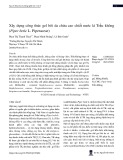
* Corresponding author.
E-mail address: m.zirak@pnu.ac.ir (M. Zirak)
© 2017 Growing Science Ltd. All rights reserved.
doi: 10.5267/j.ccl.2017.4.001
Current Chemistry Letters 6 (2017) 105–116
Contents lists available at GrowingScience
Current Chemistry Letters
homepage: www.GrowingScience.com
Three-component reactions of kojic acid: Efficient synthesis of
Dihydropyrano[3,2-b]chromenediones and aminopyranopyrans catalyzed with
Nano-Bi2O3-ZnO and Nano-ZnO
Maryam Ziraka*, Mostafa Azinfara and Mosleh Khalilia
aDepartment of Chemistry, Payame Noor University, Iran
C H R O N I C L E A B S T R A C T
Article history:
Received January 2, 2017
Received in revised form
March 1, 2017
Accepted April 21, 2017
Available online
April 22, 2017
Synthesis of pyrano-chromenes and pyrano-pyrans was developed by three-component
reactions of kojic acid and aromatic aldehydes with dimethone and malononitrile, catalyzed
with nano-Bi2O3-ZnO and nano-ZnO, respectively. Reactions proceeded smoothly and the
corresponding heterocyclic products were obtained in good to high yields. Nano ZnO and nano
Bi2O3-ZnO were prepared by sol-gel method and characterized by X-ray diffraction (XRD),
energy-dispersive X-ray analysis (EDX), Fourier transform infrared (FT-IR), scanning electron
microscopy (SEM), and transmission electron microscopy (TEM) techniques. Supporting Bi3+
on ZnO nanoparticles as Bi2O3, is the main novelty of this work. The simple reaction
procedure, easy separation of products, low catalyst loading, reusability of the catalyst are
some advantageous of this protocol.
© 2017 Growin
g
Science Ltd. All ri
g
hts reserved.
Keywords:
Kojic acid
Heterogeneous catalysis
Multicomponent reaction
Solvent-free
Nano-ZnO
1. Introduction
Multi-component reactions (MCRs) have been attracted a lot of attention in organic and
pharmaceutical chemistry because of the construction of biologically active compounds.1 Although,
these reactions are complicated than stepwise reaction, they are fast, efficient and environmentally
favorable methods.
Chromenes and pyrano-pyranes are important classes of fused oxygenated heterocycles2 with a
wide range of biological and therapeutic properties, such as antibacterial,3 anti-cancer,4 anti-
anaphylactic,5 and anticonvulsant activities.6 Also, they are extensively found in natural products, such
as biscopyran,7 Elatenyne,8 Calyxin I, Calyxin J, and Epicalyxin J.9 Therefore, the development of
efficient and convenient methods for the synthesis of chromene and pyranopyran derivatives using a
recyclable and environmentally benign catalyst is very necessary. Three-component reaction of kojic
acid, aldehyde and 1,3-dicarbonyl compounds or malononitrile is one of the most important
methodology for the synthesis of these heterocyclic systems. A various catalysts and conditions were

106
reported for this reaction, including InCl3,10 CAN,11 Al2O3,12 Bi(OTf)3,13 CeCl3·7H2O/SiO2,14 FeCl3-
SiO2,15 Fe3O4@SiO2,16 ultrasonic irradiation,17 imidazole,18 piperidine,19 Et3N,20 and NH4VO3.21 Kojic
acid and its derivatives have wide range of applications in cosmetic,22 medicine,23 food,24 agriculture25
and chemical industries.26
In the other hand, metal oxides play a crucial role in many areas of chemistry, physics and materials
science.27 Recently, heterogeneous catalysis using metal oxides has been attracted great attention due
to their potential applications in organic synthesis.28-29 Among them, bismuth and zinc oxides are as
effective catalysts because of their low toxicity, ease of handling, low cost and relative insensitivity to
air and moisture.30
In continuing our works on the heterocyclic chemistry,31-33 we report herein a one pot three-component
synthesis of chromenes and pyranopyarns from kojic acid catalyzed by nano-Bi2O3-ZnO and nano-
ZnO, respectively.
2. Results and Discussion
ZnO nanoparticles were prepared using a polyethylene glycol (PEG) sol-gel method as reported by
Amini et al.,34 by heating a solution of Zn(NO3)2 and PEG in EtOH until forming a viscous gel, followed
by drying and calcination in air at 500 °C. Then, Bi2O3-ZnO nanoparticles were prepared by adding
nano-ZnO to a solution of BiCl3 in MeOH for 24 h, and drying in air at room temperature. Obtained
nano-ZnO and nano-Bi2O3-ZnO were characterized using FT-IR, SEM, XRD, EDX and TEM analysis.
XRD pattern of the nano-ZnO shows peaks at the positions of 31.63°, 34.31°, 36.11°, 47.48°, 56.55°,
62.80°, 66.33°, 67.90° and 69.04°, which are in good agreement with reported data.34 In addition to
peaks related to nano-ZnO, peaks at the positions of 32.78°, 33.47°, 37.86°, 44.77° was appeared in
the XRD pattern of the nano-Bi2O3-ZnO, accounted to the existence of β-Bi2O335 in the composition of
nanoparticles (Fig. 1.).
Fig. 1. XRD patterns of nano-ZnO (red) and nano-Bi2O3-ZnO (black)

M. Zirak et al. / Current Chemistry Letters 6 (2017)
107
FT-IR spectrum of nano-ZnO shows peaks at 842 and 543 cm-1 that are related to the stretching
and bending vibrations of O-Zn-O bonds. The peaks of the bending and stretching vibrations of O-H
were appeared at 1620 and 3415 cm-1, respectively. Peaks at 2877 and 2910 and 1103 cm-1 are attributed
to vibrations of CH2 and C-O bond of PEG precursor. In the FT-IR spectrum of nano-Bi2O3-ZnO, peaks
at 3451 and 1623 cm-1 are attributed to the vibrations of O-H. Peaks around 906 and 726 and 481 cm-1
corresponds to the stretching vibrations of Zn-O and Bi-O and bending vibrations of O-Bi-O,
respectively (Fig. 2.).
Fig. 2. FT-IR spectra of ZnO (black) and Bi2O3-ZnO (red) nanoparticles
Particle morphology and textural properties of nano-ZnO and nano-Bi2O3-ZnO catalysts were
studied by SEM and TEM images, in which the nanoparticles of ZnO were appeared as regular
geometric shapes such as cubic and rod like materials (Fig. 3a.). SEM images of Bi2O3-ZnO showed
the similar shape with nano-ZnO with Puffy and wrinkled surface (Fig. 3b.). TEM images of Bi2O3-
ZnO revealed that the existence of ZnO nanoparticles with very tiny particles of Bi2O3 on its surface
(Fig. 3c,d.). Energy dispersive X-ray analysis was used for the elemental analysis of nanoparticles.
EDX data of nano ZnO showed the weight percentage of 89.85% and 10.15% of Zn and O, respectively.
EDX analysis of BiCl3-ZnO composite did not exhibit the Cl in the structure, where the Zn, Bi and O
weight percentage were determined as 69.39%, 19.28% and 11.33%, respectively, indicating the
formation of nanoparticles of Bi2O3 by hydrolysis of BiCl3 with water molecules on the surface of
nano-ZnO in MeOH.
The catalytic activity of the prepared nano-Bi2O3-ZnO was investigated by reacting of dimethone
and benzaldehyde with 1.1 equiv. of kojic acid in the presence of catalytic amount of nano-Bi2O3-ZnO
in EtOH under reflux conditions for 6 h, leading to corresponding chromene 3a in 40% yield (Table 1,
Entry 1). Increasing the reaction time did not improve the yield. In order to obtain the best reaction
conditions, the reaction was carried out in different solvents under reflux conditions, such as water,
MeCN, CH2Cl2 and solvent-free conditions (Entries 2-5). In water Knoevenagel product 4 was obtained
as major product along with the desired product in very low yield. However, reaction in MeCN did not
occur. In CH2Cl2, 23% of desired product 3a was obtained. Heating a mixture of kojic acid, dimethone
and benzaldehyde in the presence of catalytic amount of nano-Bi2O3-ZnO at 100 °C under solvent-free
conditions for 2 h, furnished the chromene 3a in 80% yield (Entry 5). By decreasing the reaction
temperature (Entries 5-8), not only the reaction time was increased, but also the yield was decreased,
as there is no product detected at room temperature after 8 h. When reaction was conducted at elevated
temperature (110 °C), the product 3a was obtained in 66% along with formation of a mixture of non-
isolable colored complex byproducts (Entry 9). In order to determine the optimum amount of catalyst,

108
similar reaction was performed in the presence 0.01, 0.02, 0.03 and 0.05 g of nano-Bi2O3-ZnO catalyst,
from which the 0.03 g of catalyst was selected for the best result (Entries 5, 11-13). In the absence of
nano-Bi2O3-ZnO catalyst, reaction did not afford the desired product (Entry 10). When reaction was
conducted using nano-ZnO, chromene 3a was obtained only in 20% isolated yield, with a complex
mixture of byproducts, as monitored by TLC (Entry 14). To investigate the effect of Bi3+, reaction was
also applied in the presence of BiCl3 (5 mol%), resulted in formation of octahydroxanthene 5 as major
product, along with formation of desired product in low yield (Entry 15). Recoverability of the catalyst
was studied by separation of catalyst by simple filtration, followed by washing with CH2Cl2 three times,
and then drying at 50 °C under vacuum. The remaining catalyst reloaded with fresh reagents under the
reaction conditions for four further runs, in which no considerable decrease in the yield was observed,
demonstrating that nano-Bi2O3-ZnO can be reused as a catalyst (Entry 5).
Fig. 3. SEM images of (a) ZnO and (b) Bi2O3-ZnO nanoparticles and TEM images of (c) ZnO and (d)
Bi2O3-ZnO nanoparticles
With optimum conditions in hand, nano-Bi2O3-ZnO catalyzed three component synthesis of
chromene derivatives were investigated using various substituted benzaldehydes (Scheme 1). Reactions
were carried out by heating a mixture of a substituted benzaldehyde, dimethone and 1.1 equiv. of kojic
acid in the presence of nano-Bi2O3-ZnO (0.03 g, 2.8 mol% of Bi) at 100 °C for 2 h, to afford chromenes

M. Zirak et al. / Current Chemistry Letters 6 (2017)
109
3a-h in 75-84% yields. The results are summarized in Table 2. As shown in Table 2, not only electron-
withdrawing substituted benzaldehydes, such as Cl and NO2 substituted benzaldehydes afforded
corresponding desired products in high yields, but also electron donating substituted benzaldehydes, 4-
Me and 4-MeO substituted benzaldehydes worked well under the reaction conditions.
Table 1. Optimization of the reaction conditionsa
Entry Catalyst Catalyst loading
(g) [Bi mol% ]b
Solvent Temp.
(°C)
Time
(h)
Yield
(%)
1 Nano-Bi2O3-ZnO 0.03 [2.8] EtOH Reflux 6 40
2 Nano-Bi2O3-ZnO 0.03 [2.8] Water Reflux 6 <10%
d
3 Nano-Bi2O3-ZnO 0.03 [2.8] CH2Cl2 Reflux 6 23
4 Nano-Bi2O3-ZnO 0.03 [2.8] MeCN Reflux 6 NRe
5 Nano-Bi2O3-ZnO 0.03 [2.8] SFc100 2 80, 78, 78, 72
f
6 Nano-Bi2O3-ZnO 0.03 [2.8] SF rt 8 NR
7 Nano-Bi2O3-ZnO 0.03 [2.8] SF 60 8 27
8 Nano-Bi2O3-ZnO 0.03 [2.8] SF 80 5 64
9
N
ano-Bi2O3-ZnO 0.03 [2.8] SF 110 266
10 - - SF 100 6 NR
11 Nano-Bi2O3-ZnO 0.01 [0.9] SF 100 2 58
12
N
ano-Bi2O3-ZnO 0.02 [1.8] SF 100 2 70
13 Nano-Bi2O3-ZnO 0.05 [4.7] SF 100 2 81
14 Nano-ZnO 0.03 [0.0] SF 100 2 20
15 BiCl3 0.02 [6.3] SF 100 235g
aReactions were performed using dimethone (1 mmol), benzaldehyde (1 mmol) and kojic acid (1.1 mmol); bThe mol% of Bi was calculated using EDX
analysis data as 19.28 w% Bi content of the catalyst; cSF = Solvent-free; dKnoevenagel product 4 was obtained as major product; eNR = No reaction;
fYields for runs with recovered catalyst. gOctahydroxanthene 5 was obtained as major product.
O
O
OH
HO +
O
O
ArCHO
Nano Bi2O3-ZnO
Solvent-free
100 C, 1-2 h
O
O
O
Ar O
HO
123a-h
Scheme 1. Nano Bi2O3-ZnO-catalyzed synthesis of pyrano-chromenes
Table 2. Nano-Bi2O3-ZnO catalyzed synthesis of dihydropyrano[3,2-b]chromenedionesa
Entry Ar Product Yield (%) Mp (°C)
Measured Reported
1 C6H5 3a 80 186-188 184-185 [14]
2 4-ClC6H4 3b 82 194-196 205-206 [14]
3 2-ClC6H4 3c 79 218-220 216-217 [14]
4 3-NO2C6H4 3d 84 214-216 212-213 [14]
5 4-NO2C6H4 3e 81 233-235 229-230 [14]
6 2,4-Cl2C6H3 3f 78 168-170 166-167 [14]
7 4-OMeC6H4 3g 75 177-179 178-179 [14]
8 4-MeC6H4 3h 77 216-217 214-215 [14]
aReactions were carried out under solvent-free conditions at 100 °C for 1-2 h.
The results encouraged us to investigate the synthesis of pyrano-pyran derivatives 7 via nano-Bi2O3-
ZnO catalyzed three-component reaction between kojic acid, substituted benzaldehydes and
malononitrile. By treatment of malononitrile with kojic acid and benzaldehyde in the presence of












![Hướng dẫn giải chi tiết bài tập phân li, phân li độc lập: Tài liệu [mới nhất]](https://cdn.tailieu.vn/images/document/thumbnail/2025/20251204/lethu2868@gmail.com/135x160/84711764814448.jpg)



![Bài tập Đa dạng thế giới sống [kèm đáp án/ hướng dẫn giải]](https://cdn.tailieu.vn/images/document/thumbnail/2025/20251123/thaohoang9203@gmail.com/135x160/5861763951302.jpg)









